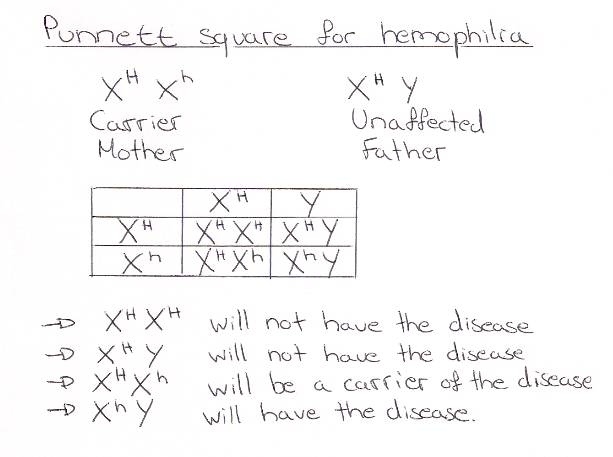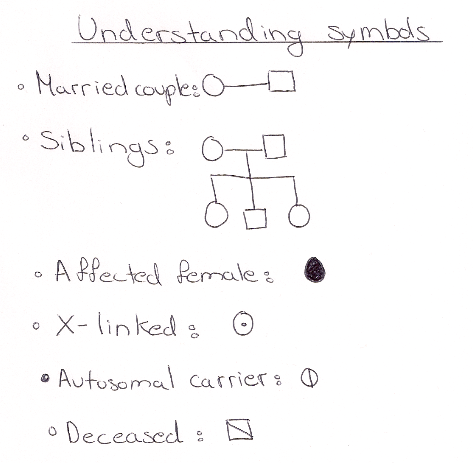Theoretical genetics
4.3.1 Define genotype, phenotype, dominant allele, recessive allele, codominant alleles, locus, homozygous, heterozygous, carrier and test cross.
Genotype: the alleles of an organism.
Phenotype: the characteristics of an organism.
Dominant allele: an allele that has the same effect on the phenotype whether it is present in the homozygous or heterozygous state.
Recessive allele: an allele that only has an effect on the phenotype when present in the homozygous state.
Codominant alleles: pairs of alleles that both affect the phenotype when present in a heterozygote.
Locus: the particular position on homologous chromosomes of a gene.
Homozygous: having two identical alleles of a gene.
Heterozygous: having two different alleles of a gene.
Carrier: an individual that has one copy of a recessive allele that causes a genetic disease in individuals that are homozygous for this allele.
Test cross: testing a suspected heterozygote by crossing it with a known homozygous recessive.
4.3.2 Determine the genotypes and phenotypes of the offspring of a monohybrid cross using a Punnett grid.

4.3.3 State that some genes have more than two alleles (multiple alleles).
Some genes have more than two alleles (multiple alleles).
4.3.4 Describe ABO blood groups as an example of codominance and multiple alleles.
The ABO blood group is a good example of codominance and multiple alleles. There are three allele that control the ABO blood groups. If there are more than two allele of a gene then they are called multiple allele. The allele IA corresponds to blood group A (genotype IAIA) and the allele IB corresponds to blood group B (genotype IBIB). Both of these are dominant and so if IA and IB are present together they form blood group AB (genotype IAIB). Both allele affect the phenotype since they are both codominant. Codominant allele are pairs of allele that both affect the phenotype when present together in a heterozygote. The allele i is recessive to both IA and IB so if you have the genotype IA i you will have blood group A and if you have the genotype IB i you will have blood group B. However if you have the genotype ii then you are homozygous for i and will be of blood group O. Below is a table to summaries which genotypes give which phenotypes.
PhenotypeGenotype
A IAIA or IAi
B IBIB or IBi
AB IAIB
O ii
Below are diagrams illustrating the inheritance of the ABO blood groups.


4.3.5 Explain how the sex chromosomes control gender by referring to the inheritance of X and Y chromosomes in humans.
There are two chromosomes which determine gender. These are called the sex chromosomes and there are two types, the X and the Y chromosome. Females have two X chromosomes whereas males have one X and one Y chromosome. The X chromosome is relatively large compared to the Y (which is much smaller) and contains many genes. The Y chromosome on the other hand only contains a few genes. The female always passes on to her offspring the X chromosome from the egg (female gamete). The male can pass on either the Y or the X chromosome from the sperm (male gamete). If the male passes on the X chromosome then the growing embryo will develop into a girls. If the male passes on the Y chromosome then the growing embryo will develop into a boy. Therefore gender depends on whether the sperm which fertilizes the egg is carrying an X or a Y chromosome.
4.3.6 State that some genes are present on the X chromosome and absent from the shorter Y chromosome in humans.
Some genes are present on the X chromosome and absent from the shorter Y chromosome in humans.
4.3.7 Define sex linkage.
Sex linkage: when the gene controlling the characteristic is located on the sex chromosome and so we associate the characteristic with gender.
4.3.8 Describe the inheritance of colour blindness and hemophilia as examples of sex linkage.
Most of the time sex-linked genes are carried on the X chromosome. Since females have two X chromosomes they have two copies of the sex-linked gene whereas males only have one since they only have one X chromosome. Hemophilia and colour blindness are both examples of sex linkage.
Hemophilia
XH is the allele for normal blood clotting and is dominate over Xh which is recessive and causes hemophilia. If a mother is heterozygous she is a carrier of the disease but does not have hemophilia as the dominate allele is present. She can however pass the disease on to her offspring. Below is a punnett showing how a carrier mother and an unaffected father can pass the disease on to their offspring.

From our four possible outcomes we can see that a female child cannot get hemophilia but can be a carrier. This is because the father will always pass on the dominate allele (XH) on the X chromosome in females. Depending on whether the mother passes on the dominant or recessive allele will determine if the female child is a carrier or is unaffected by the hemophilia. If the child is a boy then the father has passed on the Y chromosome which does not contain the allele of the gene. So whether the child has the disease or is unaffected depends on which allele the mother had passed on. If she has passed on the recessive allele (Xh) then the male child will have hemophilia, however if she has passed on the dominate allele (XH) then the child will be unaffected.
So there is a 50% chance of the child having hemophilia if it is male as half of the eggs produced by the mother will carry the recessive allele. The chance of a female offspring having hemophilia is 0% since the father always passes on the dominant allele on the X chromosome. Finally there is a 25% chance overall that the offspring will be affected.
4.3.9 State that a human female can be homozygous or heterozygous with respect to sex-linked genes.
A human female can be homozygous or heterozygous with respect to sex-linked genes.
4.3.10 Explain that female carriers are heterozygous for X-linked recessive alleles.
Female carriers for X-linked recessive alleles are always heterozygous since they require a dominant allele and a recessive allele to be carriers. They inherit the recessive allele from one parent and the dominate allele from the other. For example hemophilia is a sex-linked disease. If a carrier mother and an unaffected father have offspring then the unaffected father will always pass on his dominate allele to his female offspring. The carrier mother can either pass on the dominate or recessive allele. If she passes on the recessive allele to her female offspring than the female offspring will be a carrier as well.
4.3.11 Predict the genotypic and phenotypic ratios of offspring of monohybrid crosses involving any of the above patterns of inheritance.

Crossing between two heterozygous individuals gives a 3:1 ratio if one of the alleles is dominate and the other is recessive.
4.3.12 Deduce the genotypes and phenotypes of individuals in pedigree charts.
- Squares represent males
- Circles represent females
- Shaded symbols represent affected individuals
- Unshaded symbols represent unaffected individuals.

- If most of the males in the pedigree are affected the disorder is X-linked.
- If it is a 50/50 ratio between men and women the disorder is autosomal.
- If the disorder is dominant, one of the parents must have the disorder.
- If the disorder is recessive than neither of the parents has to have the disorder as they can be heterozygous.
